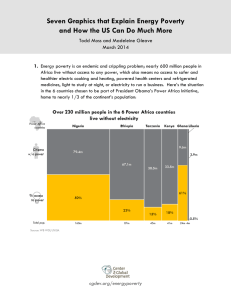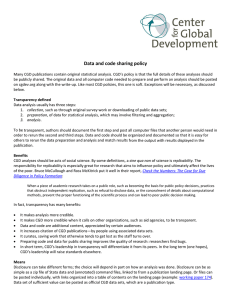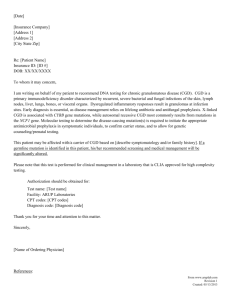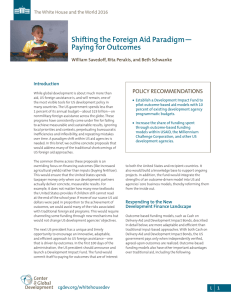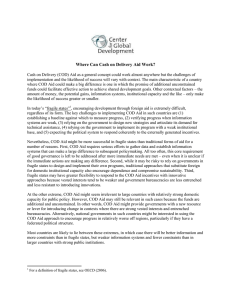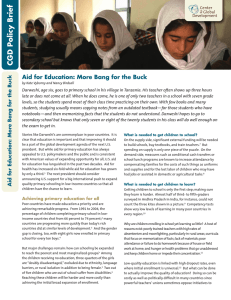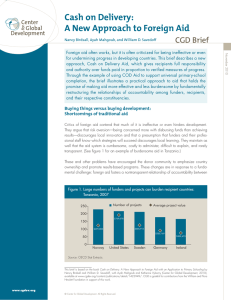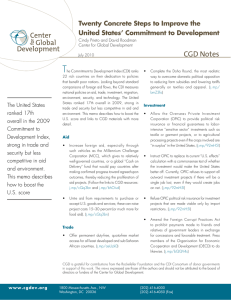CGD Notes An Introduction to Cash on Delivery Aid for Funders
advertisement
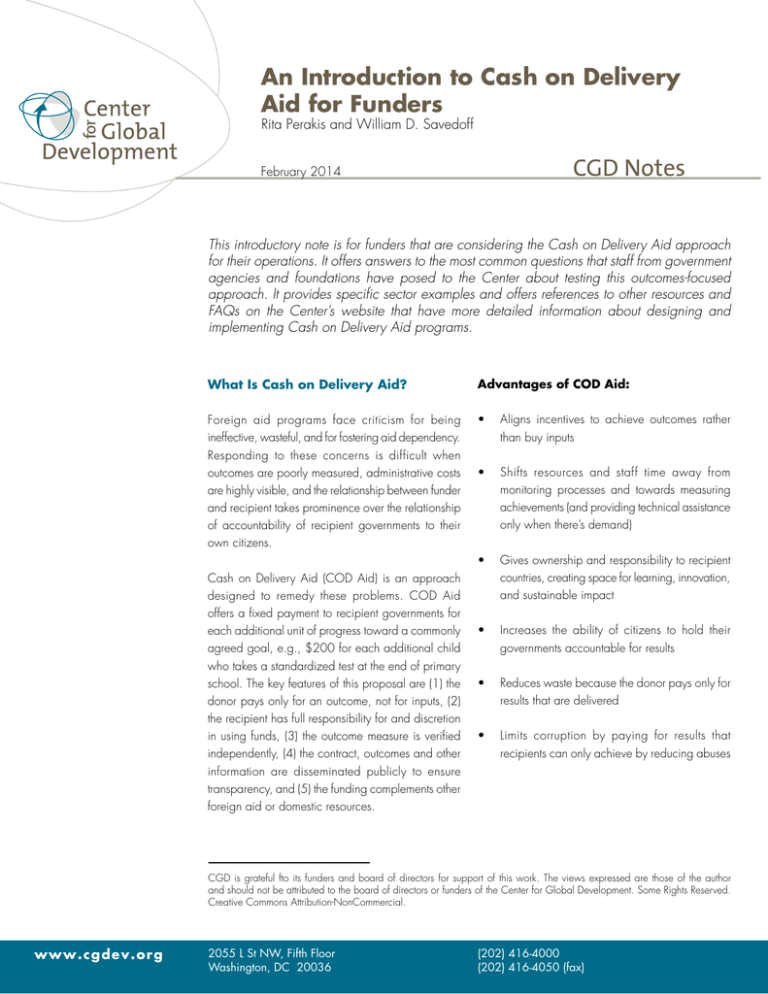
An Introduction to Cash on Delivery Aid for Funders Rita Perakis and William D. Savedoff February 2014 CGD Notes This introductory note is for funders that are considering the Cash on Delivery Aid approach for their operations. It offers answers to the most common questions that staff from government agencies and foundations have posed to the Center about testing this outcomes-focused approach. It provides specific sector examples and offers references to other resources and FAQs on the Center’s website that have more detailed information about designing and implementing Cash on Delivery Aid programs. What Is Cash on Delivery Aid? Advantages of COD Aid: Foreign aid programs face criticism for being ineffective, wasteful, and for fostering aid dependency. Responding to these concerns is difficult when outcomes are poorly measured, administrative costs are highly visible, and the relationship between funder and recipient takes prominence over the relationship of accountability of recipient governments to their own citizens. • Aligns incentives to achieve outcomes rather than buy inputs Cash on Delivery Aid (COD Aid) is an approach designed to remedy these problems. COD Aid offers a fixed payment to recipient governments for each additional unit of progress toward a commonly agreed goal, e.g., $200 for each additional child who takes a standardized test at the end of primary school. The key features of this proposal are (1) the donor pays only for an outcome, not for inputs, (2) the recipient has full responsibility for and discretion in using funds, (3) the outcome measure is verified independently, (4) the contract, outcomes and other information are disseminated publicly to ensure transparency, and (5) the funding complements other foreign aid or domestic resources. • Shifts resources and staff time away from monitoring processes and towards measuring achievements (and providing technical assistance only when there’s demand) • Gives ownership and responsibility to recipient countries, creating space for learning, innovation, and sustainable impact • Increases the ability of citizens to hold their governments accountable for results • Reduces waste because the donor pays only for results that are delivered • Limits corruption by paying for results that recipients can only achieve by reducing abuses CGD is grateful fto its funders and board of directors for support of this work. The views expressed are those of the author and should not be attributed to the board of directors or funders of the Center for Global Development. Some Rights Reserved. Creative Commons Attribution-NonCommercial. ww w . cgdev.o rg 2055 L St NW, Fifth Floor Washington, DC 20036 (202) 416-4000 (202) 416-4050 (fax) CGD Notes Where Has COD Aid Been Tried? COD Aid builds on experiences with other resultsbased funding instruments. For example, the GAVI Immunization Support Services program provided a fixed $20 payment per child vaccinated. European countries are making payments to The Amazon Fund on the basis of satellite-verified reductions in deforestation. The European Commission has implemented several budget support programs with variable tranches to increase the predictability of aid flows. The World Bank is trying a resultsbased approach through its new Program-for-Results lending instrument; eight projects have already been approved by the World Bank under this modality. The first aid program most directly inspired by CGD’s COD Aid model is a secondary education program implemented by the UK Department for International Development (DFID) and the Government of Ethiopia, which aims to increase the number of students who receive a quality lower secondary education. DFID pays the Ethiopian Ministry of Education for each student above a baseline who takes and each student who passes a grade 10 examination. The payment amount is between 50 and 100 GBP per student, with higher payments for students in emerging regions, and for girls compared to boys. DFID has committed up to a maximum of 10 million GBP each year from 2012 to 2014. How Do We Start? Funders can initiate a COD Aid program in at least two ways: by making an open offer or by negotiating a specific agreement. With an open offer, the funder designs the agreement and establishes eligibility criteria for recipients who can then voluntarily join the arrangement to receive payments on the basis of their measured progress. An open offer has the advantage of attracting recipients who are politically committed to achieving results. With a specific agreement, the 2 funder and recipient must identify a shared goal after which they can negotiate terms. In either case, the design phase includes the following aspects: • Defining a goal of common interest • Identifying an appropriate indicator for progress • Establishing a process for reporting and verifying the indicator • Choosing how much will be paid per unit of progress • Drafting and signing a contract that includes provisions for transparency to citizens • Commissioning an evaluation How Does the Recipient Government Pay for the Program? Countries that enter the COD Aid contract are not starting from a blank slate. They already have their own programs financed with domestic and foreign resources. The COD Aid funds reward countries that make existing domestic spending, technical assistance and foreign aid (if any) “pay off” in improved outcomes. Once the COD Aid payments start flowing, these funds can be used to sustain and further accelerate progress. What Is an Appropriate Indicator for Reimbursement? An appropriate indicator will be closely related to the desired goal and minimize unintended consequences. It will also be sufficiently precise to trigger periodic (e.g., annual) payments, easy to verify, and simple to explain. The payment should CGD Notes be large enough to be of interest to the recipient but it need not cover the full costs of making progress. Given the recipient’s shared interest in the goal, the payment can be thought of as a subsidy or reward that complements domestic spending. (See examples in table 1, last page). What Outcomes Is COD Aid Most Suited To? COD Aid provides funders with an opportunity to set clear, intuitive development goals and deliver identifiable and visible results for foreign aid. Some goals that could be the subject of COD Aid agreements include: children mastering basic literacy and numeracy; secondary school completion; reductions in child mortality; reductions in transportation costs; expanded access to electricity; improvements in energy reliability; higher agricultural productivity; lower poverty; reduced prevalence of smoking among youth; HIV/AIDS prevention; improved access to water and sanitation; reductions in deforestation; and adoption of low carbon energy sources (see examples in table 1, last page). References Nancy Birsdall and William D. Savedoff. Cash on Delivery: A New Approach to Foreign Aid. Washington: Center for Global Development, 2010. www.cgdev.org/publication/9781933286600-cashdelivery-new-approach-foreign-aid. Ayah Mahgoub and William D. Savedoff. “Cash on Delivery: A New Approach to Foreign Aid.” CGD Brief Washington: Center for Global Development, 2010. www.cgdev.org/publication/cash-deliverynew-approach-foreign-aid-brief. “Cash on Delivery Aid: FAQ.” www.cgdev.org/page/cash-delivery-aid-faq . Nancy Birdsall and Rita Perakis. “Cash on Delivery Aid: Implementation of a Pilot in Ethiopia.” Center for Global Development, Washington, 2010. www.cgdev.org/sites/default/files/archive/doc/ Initiatives/Ethiopia_RBA_pilot_report.pdf William D. Savedoff and Katie Douglas Martel. “Cash on Delivery Aid for Health: What Indicators Would Work Best?” CGD Working Paper 275. Center for Global Development, Washington, 2010. www.cgdev.org/publication/cash-delivery-aid-health-what-indicators-would-work-best-workingpaper-275. Robert Kaplan. “Cash on Delivery Aid for Water.” Center for Global Development, Washington, 2010. www.cgdev.org/sites/default/files/userfiles/Cash%20on%20Delivery%20Aid%20for%20Water%20 concept%20note%206_18%283%29.pdf David Wheeler, Dan Hammer, and Robin Kraft. “From REDD to Green: A Global Incentive System to Stop Tropical Forest Clearing.” CGD Working Paper 282. Center for Global Development, Washington, 2011. www.cgdev.org/publication/redd-green-global-incentive-system-stop-tropical-forest-clearingworking-paper-282 These references and further information can be found at www.cgdev.org/codaid. 3 School construction Textbooks Curriculum reform Teacher training Enrollment Health professionals Clinic construction Medical training Supplies & drugs Pipes Reservoirs Tanks Pumping stations Asphalt & gravel Community forestpreservation programs Regulatory reforms Laws to protect forests Agricultural subsidies Energy prices Generation facilities Distributed generation Efficient stoves Power lines Electricity meters Education Health W ater Transportation Deforestation Energy Inputs Sector Energy output (capacity & distribution) Reliability (outages) Functional communityprograms Enforcement of laws & regulations Higher energy prices Road of specified quality W ater connections W ater pressure W ater service Energy use Reduced energy costs Carbon footprint Financial sustainability Less deforestation More carbon sequestration Less erosion Reduced transportation costs W ater consumption Financial sustainability Mortality Disease prevalence Stunting Knowledge Competency Skills Time in class Student completion Consultations Vaccinations Growth monitoring Bed nets in use Outcomes Outputs Table 1: Examples of paying for outcomes (rather than outputs or inputs) Child mortality Disease prevalence Stunting Households consuming potable water Subsidy for revenues appropriately billed & collected Reduced transportation costs (based on survey) Rates of deforestation (satellite imagery) Households using electricity Energy costs to businesses Average daily hours of electricity Carbon fuel consumption per unit of energy Subsidy for revenues appropriately billed & collected • • • • • • • • • • 4 • • Assessed completers 12 year olds with basic literacy & numeracy skills • • Likely indicator(s) CGD Notes
